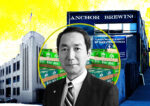Trending
The anatomy of construction corruption
How bribery and overbilling schemes have become commonplace in the world of real estate’s middlemen

In New York City’s $45.3 billion construction industry, it’s a network of middlemen that choreographs the rise of buildings. From supply companies to electrical workers, developers rely on a consortium of professionals to assign contracts and oversee the flow of millions of dollars — sometimes with little to no oversight.
“There are hundreds and hundreds of products, hundreds of different workers on the job. It’s a large undertaking,” said Barry LePatner, a construction attorney and founder of LePatner & Associates. “The owners have a tremendous amount of difficulty tracking the costs.”
Both the scale of construction projects and the number of different players involved can put developers in a vulnerable position. For instance, a property owner may pay $300 for a light fixture that cost a construction company half that. Or a subcontractor may charge a developer for seven dumpsters for a demolition project versus the four that are actually used.
In isolation, overbilling schemes like that are barely a line on a developer’s cost sheet. But compounded, such incidents can balloon into far-reaching cases of graft.
In October, state officials raided the offices of Turner Construction and Bloomberg LP as a part of an alleged overbilling scheme that may have resulted in the media company overpaying for renovation work by $1 million at its 731 Lexington Avenue headquarters. The crackdown was reportedly part of a broader probe into a suspected $100 million worth of construction fraud — the details of which remain behind closed doors at the Manhattan District Attorney’s Office. Meanwhile, last month, Mo Vaughn and Eugene Schneur’s Omni New York accused two of its property managers of conspiring with a Brooklyn-based construction supplier to jack up prices for certain materials by as much as 66 percent. And the Related Companies filed a suit against the Building and Construction Trades Council of Greater New York, also last month, alleging that the union helped inflate construction costs at Hudson Yards by more than $100 million.
But these cases aren’t one-offs. Some of the city’s top general contractors — including Tishman Construction (now AECOM Tishman), Plaza Construction, Hunter Roberts Construction Group and Lendlease — have paid millions in fines and penalties related to major fraud charges over the last three decades. And unions, too, have increasingly drawn ire for allegedly driving up developers’ expenses through what some see as tedious work rules.

Brian Fields
Interior work, property management and ground-up construction jobs involving project labor agreements have proven particularly fertile ground for accusations of corruption. That’s due in large part, experts say, to industry-wide inertia. Smaller contractors and property management firms lack the infrastructure to monitor their employees and third-party contractors closely, while deep-pocketed construction companies emerge from scandals virtually unscathed.
“The industry at large needs to own it, which it hasn’t done,” said Blake Coppotelli, a managing director at risk management firm the Freeh Group and a former prosecutor with the Manhattan DA’s office. “The industry doesn’t self-police. The pleas, the penalties, the conviction itself ends up being a business expense.”
Twice bitten
All it takes to bring the police to the door of a multibillion-dollar company is a few rogue employees.
In the case of Turner and Bloomberg, investigators believe certain subcontractors conspired with four executives — two from each firm — to secure renovation work at the financial news and information company’s headquarters, according to the New York Times. In exchange, the Turner and Bloomberg executives allegedly inflated the cost of the contracts.
Industry spectators who spoke to The Real Deal chalked it up to a few bad actors, and a spokesperson for Turner said in a statement that it’s “a shame that a few rogue employees may have acted in a non-compliant and criminal manner and tarnished the image of the companies they worked for and the industry as a whole.”
This, however, isn’t the first time Bloomberg has found itself at the center of an overbilling scheme. In 2014, the media giant’s former general contractor, Structure Tone, pleaded guilty to falsifying business records. Although Structure Tone admitted to faulty record keeping, the DA’s office had accused the firm of defrauding various clients, including the media company. What’s striking is that Turner and Structure Tone happen to be the two most active general contractors doing alteration and renovation work in New York City. Between January 2012 and March 2017, the firms worked on $2.6 billion and $1.9 billion worth of projects, respectively, according to an analysis by TRD.
Interior work is a market unto itself, most recently comprising nearly 18 percent of construction spending in the city, according to the latest numbers from the New York Building Congress. The industry is also a nerve center of sorts, as several different trades — plumbing, drywall, electric, etc. — come together to work on such projects.
With so many moving parts, including multiple subcontractors involved in individual projects, “there’s no way to protect 100 percent that a plumber isn’t giving a kickback to someone,” said one Manhattan developer who asked not to be named. “It’s impossible.”
The lack of cost transparency is one of the biggest enablers of such schemes, according to developers, contractors and legal experts interviewed by TRD. Most active developers have a good grasp on the cost of materials or services, but an office tenant doing a renovation may lack the same knowledge. In addition, because of the competitive nature of the business, many contractors initially lowball their bids to secure work and make up for the difference by overbilling, said LePatner, who recently launched a business that is aimed at revealing market prices for building materials.
As a result, several of the corruption investigations since the 1990s have focused on subcontractors because those firms “provide a window into peer-corruption and kickbacks,” Coppotelli said.
The head of one major subcontracting firm in New York said he didn’t think subcontractors were disproportionately implicated in fraud cases. “Everybody gets blamed. It’s a very complicated process,” he said on condition of anonymity. “I feel a lot of times that owners only look at price, and they don’t look at the quality of the company, the safety and the compliance programs.”

Lou Coletti
But when it comes to interior work, there’s a relatively small pool of companies equipped to do high-end office renovations and build-outs, said Bruce Maffeo, an attorney with Cozen O’Connor and a former prosecutor with the U.S. Attorney’s Office for the Eastern District of New York.
While a conviction may give a prospective client pause, it’s often not enough to convince the client to take a chance on a lesser-known contractor.
“That’s a hard risk to sell,” Maffeo said. “They don’t want to see corruption, but they don’t want to have slipshod construction in their flagship space.”
Coppotelli said that in turn, smaller and mid-level contractors tend to suffer the most following convictions because they can’t bounce back as easily from hefty fines. During Coppotelli’s tenure as chief of the DA’s construction corruption strike force from 1997 to 2001, five companies admitted to their roles in a $2 billion bid-rigging scheme in which general contractors and subcontractors paid bribes to secure renovation work for Sony, Morgan Stanley and other major clients. Construction consulting firm Bennis & Reissman closed down soon after its guilty plea, and interior contractor AJ Contracting filed for bankruptcy (though Conde Nast would later hire one of Bennis & Reissman’s founders, Robert Bennis). Structure Tone, another one of the firms that pleaded guilty in the scheme, paid a $10 million fine but then continued to grow its business, maintaining its throne as one of the largest interior contractors in the nation.
Structure Tone is not the only major firm that’s rebounded from scandal. Lendlease — the third most active contractor in ground-up projects — paid a $56 million fine as part of an April 2012 settlement regarding claims that it paid bogus overtime to workers on various projects, including the renovation of Grand Central Terminal. And before Tishman Construction was acquired by AECOM in 2010, it paid more than $20 million in fines after officials claimed the company overcharged for work on One World Trade Center, the Jacob K. Javits Center and other projects.
“The larger ones that have been caught up in these investigations end up surviving because the industry and clients don’t hold them accountable,” Coppotelli said.
Property mismanagement
On the whole, property management has come a long way from its rampant kickback schemes in the 1990s, when authorities charged more than 80 property managers and companies with extorting millions from contractors in exchange for work. As more luxury condos and rentals proliferate throughout New York City, management firms have become more professionalized. And landlords are increasingly seeking third parties that offer concierge-like services over someone who just coordinates repairs.
These days, it’s the less corporate property managers — which lack the same level of oversight as some of the city’s top companies — that often find themselves at the center of scandals. The managers deal directly with decision makers in various city agencies and oversee the work when subcontractors are hired to do repairs and inspections on the sites they manage — all of which has repeatedly proven problematic.
Coppotelli explained that situations where two third parties work together — a property manager and a subcontractor hired to do construction work, for instance — can be especially susceptible to corruption. As a result, bribery is pervasive in the property management industry. Late last year, investigators untangled a messy web of such construction-related schemes.
 During a 15-month investigation, authorities found that property owners, managers and others paid a Brooklyn gas company to illegally deliver gas to properties that didn’t have city approval to receive it. The probe unveiled an “underground, shadow utility” within the Brooklyn Union Gas Company and found that the firm set up illegal gas meters and, in some cases, dug up city streets to work on gas mains without authorization. As a result, 36 people, including eight of the company’s former employees, were arrested in January 2017.
During a 15-month investigation, authorities found that property owners, managers and others paid a Brooklyn gas company to illegally deliver gas to properties that didn’t have city approval to receive it. The probe unveiled an “underground, shadow utility” within the Brooklyn Union Gas Company and found that the firm set up illegal gas meters and, in some cases, dug up city streets to work on gas mains without authorization. As a result, 36 people, including eight of the company’s former employees, were arrested in January 2017.
A court-ordered wiretap helped expose the scheme, which inadvertently revealed three other construction conspiracies and resulted in the arrest of 11 property managers in October. In one of the instances, two Brooklyn-based property managers allegedly paid off an inspector to falsely certify that seven properties in Brooklyn and Queens were asbestos free.
Instances of corruption also occur when landlords manage their own properties. For example, in May 2017, landlord and property manager Herman Epstein — who ranked among the top 20 worst landlords on the Public Advocate’s annual list in 2015 — was sentenced to up to six years in prison for bribing New York City Department of Buildings officials to remove complaints, violations and stop-work orders at his properties. He was one of more than 50 people charged in a broader bribery investigation that involved $450,000 in bribes connected to 100 residential and commercial properties in Manhattan, Brooklyn and Queens.
At the time, Manhattan DA Cyrus Vance called him a “serial briber.”
Last year’s convictions of Epstein and other property managers were orchestrated by the DA’s office and the Department of Investigation. And two years earlier, Vance launched the Construction Fraud Task Force to target a laundry list of shady practices in the industry — including bribery, extortion, larceny and bid rigging — thanks in large part to the high volume of construction in the city. However, due to a number of ongoing investigations, including the Turner case, the DA’s office declined to comment for this story. The DOI declined to comment as well.
There’s also a long history of organized crime involvement in such schemes — and it hasn’t completely disappeared. In March, two contractors — one of whom was described as a “mafia soldier” for the infamous Genovese family — were indicted for allegedly rigging contracts for plumbing, HVAC and sprinkler work at a luxury residential building in Brooklyn.
And graft still creeps its way up to larger firms. In Omni’s recent suit against its longtime building materials supplier, Berkoff Supply, the affordable housing developer alleged that Berkoff routinely inflated its prices. The supply company is accused of scheming with an employee of the landlord’s property management arm, Reliant Realty Services, and another Omni employee to increase the cost of products by as much as 66 percent. In one instance, Berkoff charged Reliant $81.51 for each stair tread it ordered when the supplier charged others $48.95, the lawsuit claims. The ploy was discovered by an Omni employee who had previously worked in law enforcement.

731 Lexington Avenue
Omni is seeking at least $1 million in damages. While the landlord and its subsidiaries claim to have ordered roughly $500,000 worth of materials from Reliant since 2010, the lawsuit doesn’t specify how much Berkoff allegedly stole. Representatives for Omni declined to speak about the case, and Berkoff didn’t respond to multiple messages seeking comment.
When it comes to overbilling schemes, some say developers are also responsible for monitoring their own flow of cash and flagging something that might look suspicious. “If [the bill’s] way out of whack, the ownership should be questioning it. That’s legitimate,” said Subcontractors Trade Association Executive Director Hank Kita. “Any subcontractor, if they are quizzed by the construction manager or owner on the price of materials, everybody I’ve dealt with from my organization would be pretty straightforward.”
He added that owners sometimes don’t factor in the cost of transporting or storing materials, which may lead to some misunderstandings over line items on a bill.
Still, that’s not always the case. “As in any business, there’s a small minority who think that they can get away with taking bribes,” LePatner said.
Blame it on the coffee boys
In March, a subsidiary of Related Companies filed a lawsuit against Building and Construction Trades Council of Greater New York and its president, Gary LaBarbera, alleging that the union’s labor policies drove up costs at Hudson Yards by more than $100 million. The bills were increased, for example, by having two higher-ranking union members of the Concrete Workers District Council serve as “coffee boys” — roles that are usually filled by the most junior members, according to the complaint. They were supposedly paid $42.48 an hour, plus $27.39 worth of benefits, to deliver coffee to workers on the site.
The litigation springs from an ongoing dispute between the BCTC and Related over the developer’s decision to go open shop for 50 Hudson Yards and the remaining second phase of the 26-acre megaproject. William Wachtel, an attorney for Related, said the company prefers to hire union labor on a trade-by-trade basis rather than work through the BCTC.
“The simple fact is, dealing directly with unions and their leadership is a healthier relationship than working through someone like Gary LaBarbera,” Wachtel said. “He’s got a job to do, but that job is old school, and it’s time for people to realize that the new approach is the only way we’re going to put life back into unions.”
In response to Related going open shop, the BCTC has called for all unions to refuse work at Hudson Yards, the lawsuit claims. The trade group has also questioned the timing of Related’s lawsuit.
“This complaint asks us to believe that for six years, [Related] did nothing to curtail practices they believed to be corrupt and these allegations piled up until this complaint was filed,” a representative for the BCTC said in a statement. “If the bizarre allegations are to be believed at all, this also means that Related sat idly by while contractors were overbilling them.”
Related flagged these issues earlier, albeit not publicly, Wachtel said. The developer initiated the legal battle primarily because of LaBarbera’s efforts to deter all unions from working at 50 Hudson Yards. More claims may be on the way, he noted.
The attorney said that publicly challenging the BCTC over issues would have likely resulted in delaying the project and possibly even in retaliation from workers. Often when issues arise between an owner and the construction team on a project, they are resolved quietly. The developer usually can’t afford to wage a legal fight that could delay construction. “If you are in the middle of the Atlantic Ocean, and you feel like you don’t like the direction the ship is going in, you usually don’t complain too much because the water is awfully deep,” Wachtel said.
Related’s claim isn’t uncommon. Many developers have had disagreements with unions over project labor agreements — a collective bargaining contract that ensures the use of union workers on a project. The subject has gotten a lot of attention lately due to the financial woes of the Metropolitan Transportation Authority and the New York City Housing Authority.
A New York Times report late last year showed that the prominence of certain trade groups and excessive staffing was at least partially to blame for the ballooning costs of transit projects in the city. Meanwhile, NYCHA spent $341 million from 2014 through 2017 on overtime costs required by labor contracts. Though the agency’s head, Shola Olatoye, is fighting to change some of the union rules, she doesn’t have the backing of City Hall, Politico reported.
“Whether a result of fraud, or simply incompetence, or the self-destructive rules that we impose on our public agencies, the cost of construction on public projects in New York is truly astronomical,” said Seth Pinsky, executive vice president and investment manager at RXR Realty. “It’s not that fraud is viewed as a cost of doing business, but losses and inefficiencies are certainly viewed too frequently as a cost of doing business in New York, especially in the public sector.” He added that although a half percentage lost here or there may not always get caught, “the absolute dollar amounts that are being lost in those circumstances are meaningful,” especially when dealing with multibillion-dollar projects for cash-strapped agencies.
Lou Coletti, president of the Building Trades Employers’ Association, attributes many developers’ grievances over cost to the inability of some unions to find lower-level workers to join projects. To become more competitive, some groups, including the New York City District Council of Carpenters, have tried to create blended-rate workforces, meaning they bring on more employees who are paid less than highly skilled journeymen. Coletti said these cost-saving strategies aren’t always achieved because the unions have a difficult time finding workers to fill those lower-rate slots.
“That’s not a lack of transparency. That’s a lack of ability to carry out some of the new cost reduction strategies that may have been adopted,” Coletti said. “I think people use transparency as a catchall for every issue under the sun.”
Checks and balances
Long before Structure Tone’s 2014 guilty plea, the company had been revamping its compliance programs, according to the firm’s CEO, Bob Mullen. He noted that the case referred to actions in 2005 through 2009 that largely sprung from record-keeping issues that were rectified by — among other things — establishing dozens of different “control points” where employees have to document every interaction with clients regarding the project. The company also hired a chief ethics and compliance officer, Brian Fields, the following year. Every employee goes through compliance training, which uses the firm’s “anti-corruption manual.”
Mullen said that some clients were a bit gun-shy following the 2014 case, but Structure Tone was able to maintain those relationships. “Some clients, especially those with big internal compliance departments, certainly put us through rigorous, thorough review processes,” he said. “In some cases, it took well over a year to get through that.”
Many construction companies have a system of stops in place to prevent issues such as overbilling from slipping through the cracks.
Joseph Aiello, COO of Broadway Construction Group, said that his Manhattan-based construction management company assures that change orders and payments are overseen by numerous parties and that owners are directly part of the process.
“Some companies run things through a purchasing department, so it only goes through one set of hands, which I don’t think is a good practice,” Aiello said. “There always needs to be checks and balances. The more people who touch a document, the more honest and transparent you are. It’s more difficult to get multiple people to collaborate in corruption than one guy.”
When a company is able to show that it has controls in place, it’s less likely that it will be dragged through a criminal case. Instead, investigators will home in on an individual or small group of people who circumvented the company-imposed rules or regulations. Such is the case with Turner, which is being considered a witness in the DA’s investigation, according to its spokesperson.
The Subcontractor Trade Association’s Kita said that the overbilling scheme seemed to be a case of a few “bad apples,” but would still, at the very least, induce self-reflection among both construction companies and developers.
“There’s a human factor in this particular case. These were folks who were in cahoots with each other, and they got away with it for a while,” Kita said. “But they were eventually caught, and I think that’s a cautionary tale for anyone thinking of doing something like this.”
Fields and Mullen pointed out that construction management doesn’t exactly have industry-wide regulations for how to run a project. Beyond building codes and zoning rules, there isn’t a step-by-step “playbook” for construction firms.
“You look at the financial services companies. They have robust compliance. How much of that is internal desire, and how much of it is external pressure?” Fields said. “Here in construction, there is no external pressure. It’s all internal.”




